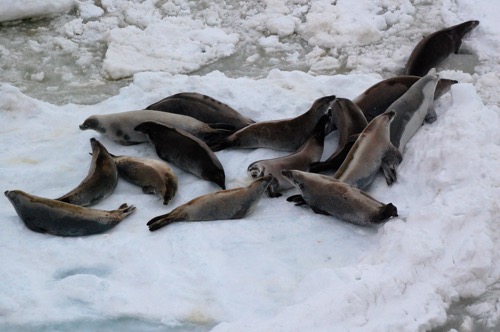Science Update
Today is day 10 of the current incubation experiment. We were planning to set up incubation experiment #2 today, however, the winds are making it a little difficult. Today may end up being a day to catch up on data entry and prepare bottles and filters for a long day of incubation set-up tomorrow.
TGIWF - Thank Goodness It's Wildlife Friday
This past week we were able to spend time in the Erebus & Terror Gulf and Duse Bay. These areas are on the eastern side of the Antarctic Peninsula. According to our captain Brandon Bell, this area is not visited as much as the western side of the peninsula. Knowing this, I was sure to be on the bridge during my free time to observe and photograph this beautiful location. When we entered Duse Bay, everyone on the bridge was struck by the beauty. Large glaciers nestled between volcanic ash-covered mountains. The sun was shining brightly off of the fast ice (ice connected to the coast) and the light winds created small ripples on the water. As we approached the fast ice, small dark dots appeared on the fast ice. Some were skuas (birds), but most were seals.
 On approach to Duse Bay in the Weddell Sea, ice floes can be seen floating away from the fast ice. The small dark spots on the ice are sleeping crabeater seals. Photo from the bow of the RVIB Palmer.
On approach to Duse Bay in the Weddell Sea, ice floes can be seen floating away from the fast ice. The small dark spots on the ice are sleeping crabeater seals. Photo from the bow of the RVIB Palmer.
 From the bridge of the RVIB Palmer looking down on the fast ice. Groups of crabeater seals are seen scattered across the ice, even off in the distance.
From the bridge of the RVIB Palmer looking down on the fast ice. Groups of crabeater seals are seen scattered across the ice, even off in the distance.
Since we spent a number of days near these seals, I decided to highlight this interesting pinniped species for this week's wildlife Friday.
Crabeater Seals (Lobodon carcinophaga)
Crabeater seals (Lobodon carcinophaga) are one of the most abundant species of marine mammals in the world. They are estimated at the low range of 10-15 million and at the high range at 50-75 million individuals. Crabeater seals are large, slender seals that are found only in Antarctica. These seals reach average lengths of 6.5 ft and weigh close to 500 lbs. Crabeater seals appear long and slender in comparison with other seals from this area, especially the very rotund Weddell Seals (Leptonychotes weddellii). Crabeater seals range from tan to dark brown to any shade of grey. Young crabeater seals usually have a dark dorsal (back) side and a light ventral (belly) side. This is referred to as counter-shading and is a way to help protect the young seals from predators like leopard seals and orcas. Crabeater seals also differ from other seals in this area because they tend to form large groups that rest on the ice together, or forage together in the water.
 Crabeater seals are known to congregate into groups. This group of fifteen crabeater seals is not uncommon in Antarctica.
Crabeater seals are known to congregate into groups. This group of fifteen crabeater seals is not uncommon in Antarctica.
Crabeater seals survive on a diet of krill. In fact, krill makes up about 90% of their diet. Most other seals rely on fish or, in the case of leopard seals (Hydrurga leptonyx), small seals and penguins. Because most other seals do not primarily eat krill, the crabeater seals have very little competition for food. Crabeater seals have highly specialized teeth to help them filter krill from the water. These krill-filtering cusps are found along the sides of the seals mouth. As the seals gulp water, they can push the water through small openings in the teeth. This traps the small shrimp-like crustaceans in their mouth, while the salt water filters out.
![By Dimitri Torterat (Diti) (Own work) [GFDL (http://www.gnu.org/copyleft/fdl.html) or CC-BY-SA-3.0 (http://creativecommons.org/licenses/by-sa/3.0/)], via Wikimedia Commons Crabeater seal teeth diagram](/files/members/cara-pekarcik/images/2000px-lobodon_carcinophaga_teeth.jpg) By Dimitri Torterat (Diti) (Own work) [GFDL (http://www.gnu.org/copyleft/fdl.html) or CC-BY-SA-3.0 (http://creativecommons.org/licenses/by-sa/3.0/)], via Wikimedia Commons
By Dimitri Torterat (Diti) (Own work) [GFDL (http://www.gnu.org/copyleft/fdl.html) or CC-BY-SA-3.0 (http://creativecommons.org/licenses/by-sa/3.0/)], via Wikimedia Commons
Crabeater seals generally forage at night when the krill move from the deep waters to the surface. The seals can forage along the edge of the fast ice and may even swim under the ice to feed on krill. Watch the video below to see these crabeater seals in action.


Comments